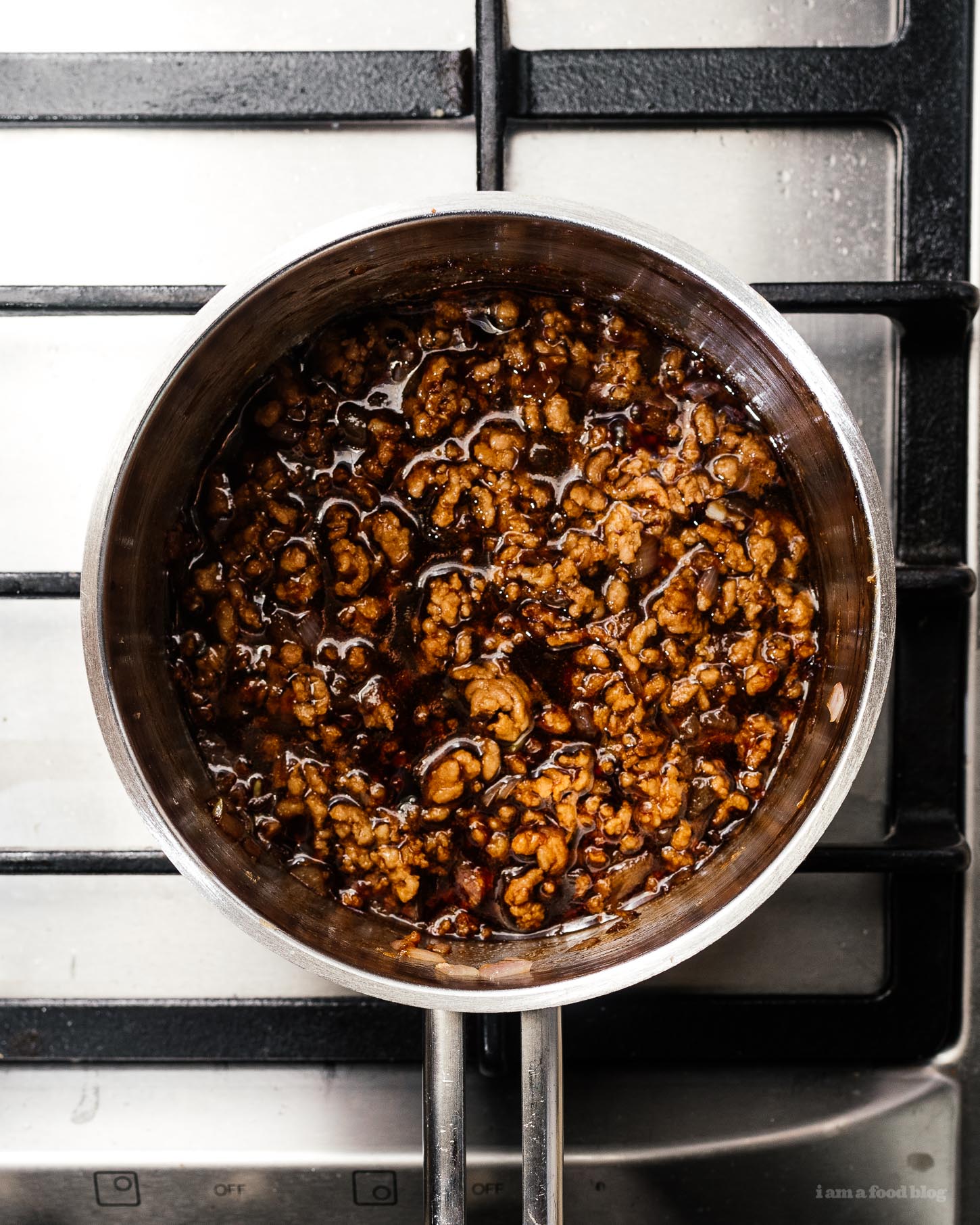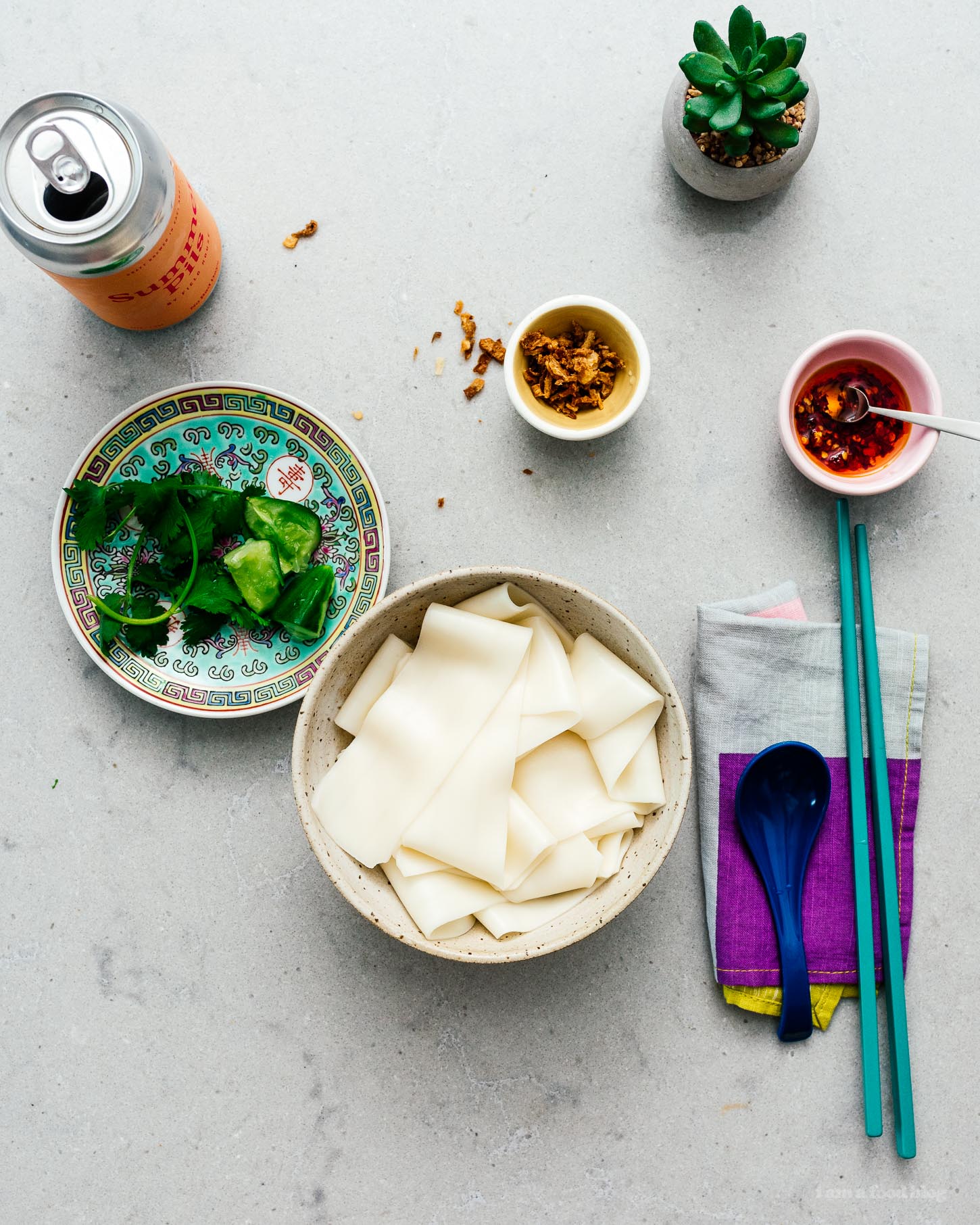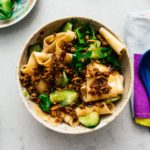If I had to choose a noodle that I could name as my number one top comfort food and eat forever and ever it would be zha jiang mian or “fried sauce noodles.”
It’s an absolute breeze to make the sauce and it keeps well in the fridge which means bowls of salty, sweet, and savory noodles are ready in a flash.
What is zha jiang mian?
Translated, zha jiang mian means “fried sauce noodles” in Mandarin and essentially that’s what it is: a bunch of sauces fried up together and served tossed with noodles. It’s originally from Beijing and made with two types of fermented bean paste: ganhuang jiang (fermented yellow soy bean paste) and tianmian jiang (sweet fermented flour and bean paste). These two pastes combine together into an AMAZING salty, sweet, punchy, complex sauce.
The meat sauce is kind of reminiscent of a Chinese Bolognese except it only takes 15 minutes to make. For this version we’re going for quick and easy. This zha jiang mian is crazy delicious even when it’s simplified by using easy to find Chinese ingredients – the kind you can find at Target. Make a double batch and keep it in the fridge: you can add as much or as little sauce as you like to your noodles. If you love noodles and meaty sauce, you’ll love this. It’s full of umami, sweet and salty flavors, and it tastes like comfort in a bowl. The deep punch of flavors is offset but crunchy, juicy cucumbers and the contrast between the freshness of the cucumbers, the savoriness of the sauce, and the chewiness of the noodles will make you want to eat more and more.

Zha jiang mian ingredients
- shallots and garlic – shallots and garlic together are the ultimate aromatics. Shallots are sweeter and more pungent yet mellow compared to onions and garlic, well, everyone knows how amazing garlic is. Simmered in hot oil until soft, the aromas of shallots and garlic let you know something good is on the way.
- ground pork – ground pork is my favorite meat for zha jiang mian because of it’s sweet porky flavor and fat content. It’s more tender than using ground beef and has more flavor than ground chicken or turkey. You can use any minced meat you like, but pork is the classic.
- hoisin sauce – hoisin sauce is a Classic Chinese sauce that adds so much flavor. Hoisin is pretty much sold everywhere now, from Target to your basic grocery store, and of course, online. It’s a thick, sweet brown sauce that’s used in marinades and as a dipping sauce. It’s super flavorful: sweet, savory, and slightly tangy.
- oyster sauce – this is the secret ingredient that adds a huge amount of umami and seafood flavor to the sauce. more on this below
- dark soy sauce – not just your regular soy sauce, more on this below
- sugar – a little bit of sugar adds some sweetness making this dish one that both kids and adults love
- noodles – you’ll find zha jiang mian served with wheat noodles in Beijing, but you can serve them with any noodle you like. If you want to go the traditional noodle, look for a white wheat noodle in the fridge section at your local asian grocery store.
- cucumbers – julienned cucumbers add crunch and freshness that contrasts with the meaty sauce, highlighting the sauces savoriness.
Oyster sauce
Oyster sauce is sweet and thick and full of complexity. It can be found in the Asian aisle of any grocery store or online. If you see the Lee Kum Kee bottle with the two people in boats, go for that one. It’s the premium oyster sauce which lists oysters as its first ingredient. Oyster sauce doesn’t taste super seafood-y but it definitely adds an extra oomph to this sauce that you won’t be able to put your finger on.
Dark soy sauce
This is a thicker, darker soy sauce that’s not as salty as light soy sauce and it’s used mostly to add a beautiful color to your noodles, but it also has a caramel note too it. It’s readily available online and at well stocked grocery stores. You can sub regular soy sauce if you don’t have dark, but it’s what gives these noodles their gloss.
How to make zha jiang mian
- Fry the aromatics. Fry some shallots and garlic in oil until soft and fragrant.
- Cook the pork. Add the ground pork and cook it, breaking up, until browned.
- Fry the sauces. Add hoisin, oyster, dark soy sauce, sugar, and a bit of water and simmer until the sauce thickens and all the flavors meld.
- Mix. While the sauce is doing it’s thin, cook your noodles and drain well. When the sauce is ready, mix a generous portion with the noodles.
- Enjoy. Slurp and enjoy topped with cucumbers and green onions or cilantro!

What kind of noodles?
I love this meat sauce with all sorts of noodles. Traditionally zha jian mein comes with thick wheat flour based noodles (look in the fridge section of your local Asian grocery store), but the sauce tastes fantastic with spaghetti and I’ve been known to mix it up with rice noodles as well. Go wild, it’s a tasty savory meat sauce that pairs well with virtually any noodle. Try it with:
- Chinese wheat noodles
- udon
- rice noodles
- vermicelli
- egg noodles
- lo mein noodles
- pasta
Vegetables
Usually you’ll see zha jiang mian served with fresh vegetables, a rarity in Chinese food, but the freshness of cucumbers goes so amazing with the super umami meaty flavors – the contrast is just insane. Some other vegetables you can try:
- shredded carrots
- shelled edamame
- sliced radishes
- bean sprouts
- thinly sliced celery
- shredded cabbage
- green onions
- cilantro
- shredded zucchini

Zha jiang mian vs jajangmyeon
If you’re a fan of Korean food, you’ve most likely had jajangmyeon, those super flavorful noodles covered in black bean sauce. Jajangmyeon is a Korean take on zha jiang mian using the ingredients they had back when globalization wasn’t quite was it is today. Jajangmyeon is noodles covered in a thick sauce made with diced pork chunjang (black bean paste) served with vegetables.
Vegetarian zha jiang mian
If you’re vegetarian, you can absolutely make this zha jiang mian with tofu. I find that extra firm tofu, crumbled, is the best in terms of texture and flavor. Crumbled tofu really mimics ground meat and the ground tofu soaks up all the sauce ingredients perfectly.

Zha Jiang Mian Recipe
Bouncy noodles in an AMAZING salty, sweet, punchy, complex sauce.
Serves 2
- 2 tsp neutral oil
- 2 shallots diced
- 4 cloves garlic minced
- 1/2 lb ground pork
- 2 tbsp hoisin sauce
- 2 tbsp oyster sauce
- 2 tbsp dark soy sauce
- 1 tbsp sugar
- freshly ground pepper to taste
- 2 portions noodles of choice
- cucumbers to finish
- fresh cilantro roughly chopped, to finish
-
In a pot, heat up the oil over medium heat. Add the shallots and garlic and cook, stirring, until soft and fragrant. Add the pork and cook, breaking up, until no longer pink. Stir in the hoisin, oyster, dark soy, sugar, and 2 tablespoons of water. Let simmer over low heat for 5-10 minutes, stirring occasionally. Taste and adjust seasoning if needed. Season with pepper.
-
While the sauce is cooking, prep the cucumbers and cilantro. I smashed the cucumbers and broke them into small pieces, but traditionally the cucumbers are julienned.
-
Cook the noodles according to package instructions and drain well. Toss with the sauce and serve with cucumbers and cilantro on top. Enjoy immediately.
Estimated nutrition doesn’t include your noodles of choice.
Nutrition Facts
Zha Jiang Mian Recipe
Amount Per Serving
Calories 281
Calories from Fat 82
% Daily Value*
Fat 9.1g14%
Saturated Fat 2.1g13%
Cholesterol 83mg28%
Sodium 556mg24%
Potassium 556mg16%
Carbohydrates 17.8g6%
Fiber 0.6g3%
Sugar 10.9g12%
Protein 30.9g62%
* Percent Daily Values are based on a 2000 calorie diet.






More Stories
Grilling Tips – What to Know Before Grilling Mahi Mahi
Grease and Oil Free Fryers – Tips On How You Could Get The Best One
3 Essential Tips For Cooking Fish On The Grill